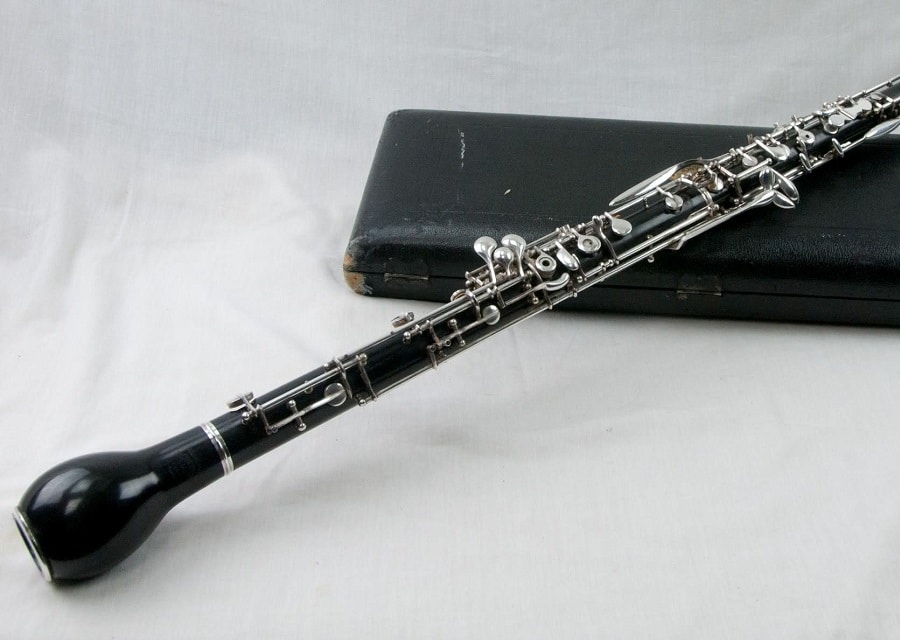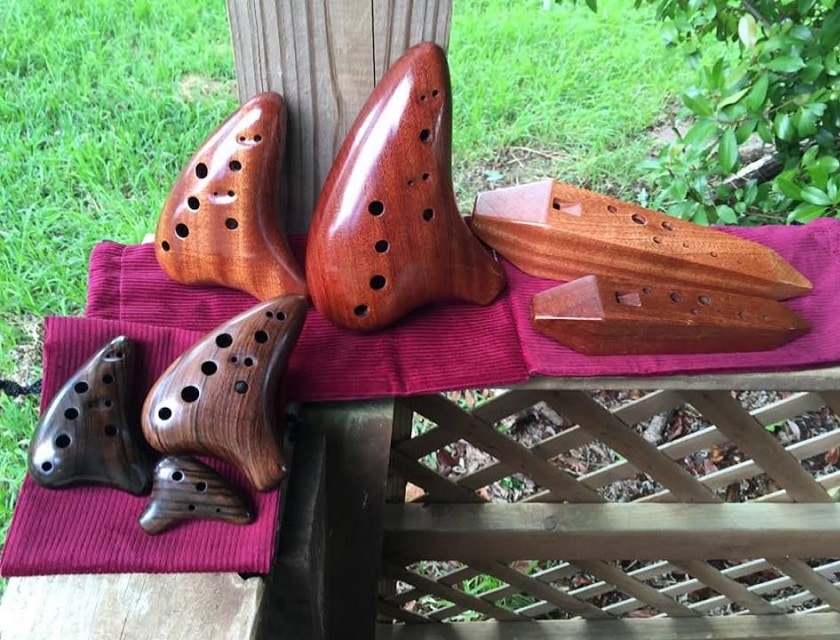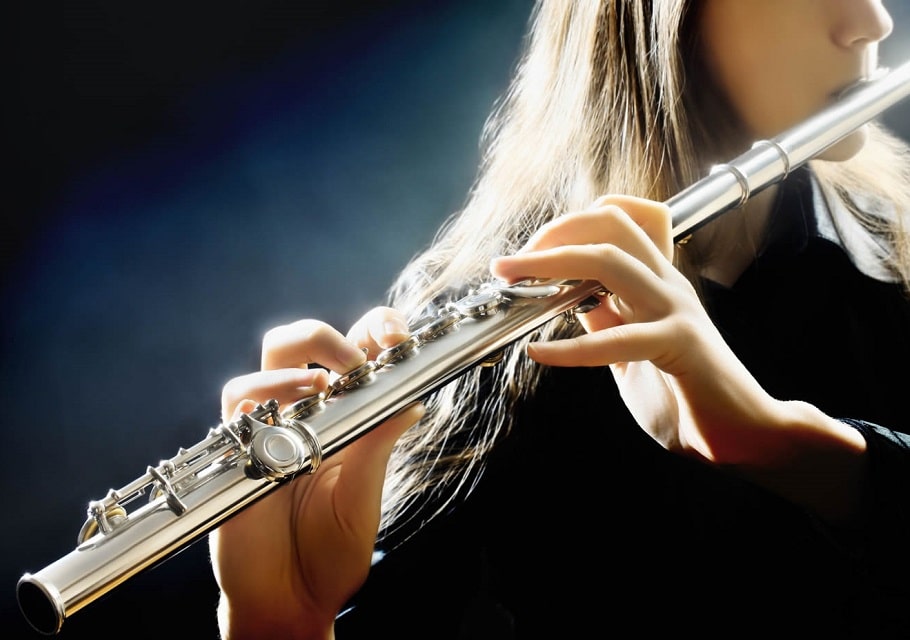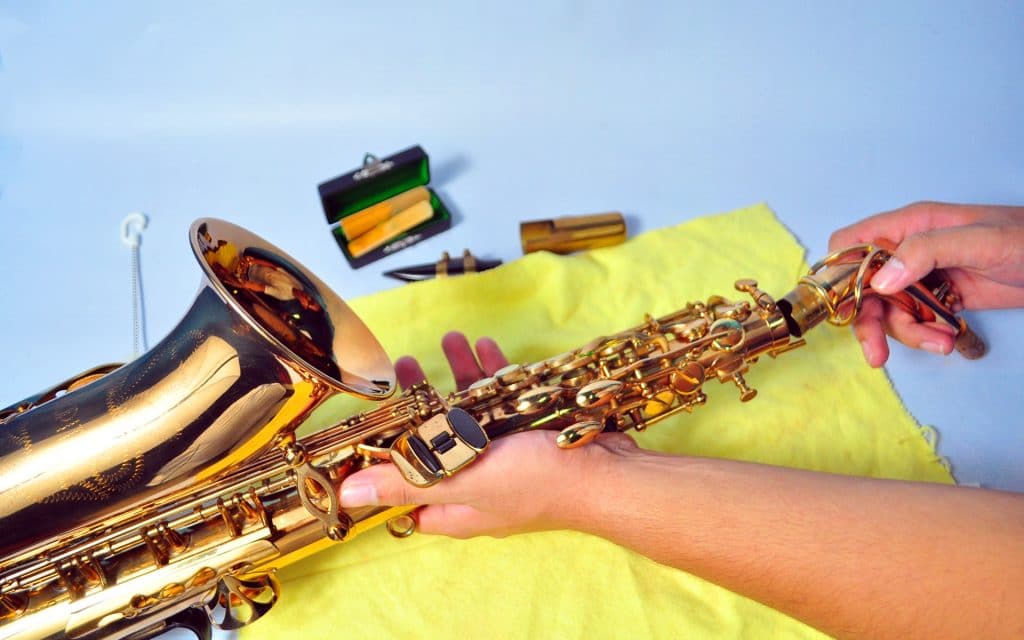Judging by the looks, Irish bagpipes look like their Scottish counterparts. They also have similar sounds to offer. But they are two completely different instruments. They have similarities, but they differ in some key features.
Though they both look and sound similar, they differ in the number of octaves, how to play them, and the number of scales you can use to play them.
Scottish bagpipes are played while standing up, and you blow into the mouthpiece. On the other hand, the Irish variants are played while sitting down, and their bellows blowdown. These bellows are right underneath the dominant arm of the player. Moreover, Irish bagpipes are also called Uilleann pipes.
They both are native instruments and originated from Celtic Gaelic origins. So, it’s not a surprise they sound pretty much similar. But there is a lot more on offer if you compare them both with one another, and we will do just that in this post.
So, scroll down to get the full scoop.
What Is an Irish Bagpipe?
Irish bagpipes, also called Uilleann pipes, are younger than their Scottish counterparts. And due to this, they are slightly more complex in their construction and have some critical differences.
The wind of the bagpipes comes from their bellows and not from the mouth of the player, as we have mentioned above. You have to hold this bellow right underneath your dominant arm and push it with your elbow for the airflow to get going.
The chanters present on this bagpipe have double reeds. And they are meant to be placed on your lap while sitting and playing them. Along with the bellow part and the design, this bagpipe is for playing as you sit and not while standing or marching.
The range of these changes on an Irish bagpipe is wider. Therefore, they can conveniently fit a couple of octaves instead of just one. You can also shut down these chanters along with the drones. It gives you much more control over the sounds that you are playing.
However, the primary difference comes due to the regulators. These regulators are uniquely present on Irish bagpipes. They are present in a set of three, and they resemble those chanters with reeds and holes. These regulators are placed on your lap next to the chanters as you sit and play them.
Hence, you can play chords and elaborate melodies using your Irish bagpipes than Scottish bagpipes. Moreover, you should also note that these bagpipes are more expensive due to their complexity as they need more time to construct due to these tiny details.
Irish Bagpipe Features
Bellows
This part is what makes the Irish bagpipes different from Scottish bagpipes. They have bellows, and there is no blowpipe here. You can control these bellows with the help of your elbows, and that’s why these bagpipes are also referred to as elbow pipes. The bellows are present right underneath your dominant arm while holding the bagpipe.
Chanter
The Irish bagpipe’s chanter is different from its Scottish cousin. Irish bagpipe chanters have a double-reed design, and they rest on your thigh as you play the instrument. Due to this, these bagpipes produce the best sound when you are sitting down.
Moreover, the range of these chapters is different. Scottish bagpipes only have a single octave and a note. On the other hand, Irish bagpipes have a couple of octaves along with all accidentals. With this kind of range and scale, there are different fingering techniques that you can use to play this instrument.
The scale itself is a pretty major difference here. Scottish bagpipes are pretty much limited here. Irish bagpipes can turn into a variety of keys. And the most frequent tuning in the D key, these bagpipes also come with flat sets that you can tune in C#, C, B, and B♭.
Thus, the overall tuning of the chanter relies heavily on the length. And the tuning of the D key is frequently used by different ensembles. However, the fault sets are often played solo.
A couple of major differences include the inner bore shape and the chanter’s end. Irish bagpipes, unlike their Scottish cousins, have cylindrical inner bore shapes. It produces that iconic soft yet sweet tune than Scottish bagpipes’ percussive and loud sound.
The end of an Irish pipe chanter is different, too, and you can close or open them. Due to this, you can play the Irish pipe in staccato. Irish pipes can also produce Tremolo and Vibrato effects.
Drones
Irish pipes’ drones work similarly to the Scottish ones. But you can tune these drones and switch them on and off at will during the play using the switch. This switch can either be a stop key or any other sliding component.
The standard set of drones will have three of them, as in the case of the Scottish version. These drones are a baritone drone, a bass drone, and a tenor drone. These drones tune to the chanter’s bottom note across all three octaves.
Regulators
This is the primary feature that differentiates Irish bagpipes from Scottish bagpipes. Standard Irish bagpipes come with three different regulators, and they are pretty similar to chanters with note holes.
Spring keys close the regulators’ ends and rest on your lap as you play. These regulators produce chords that are simple and rhythmic.
What Is a Scottish Bagpipe?
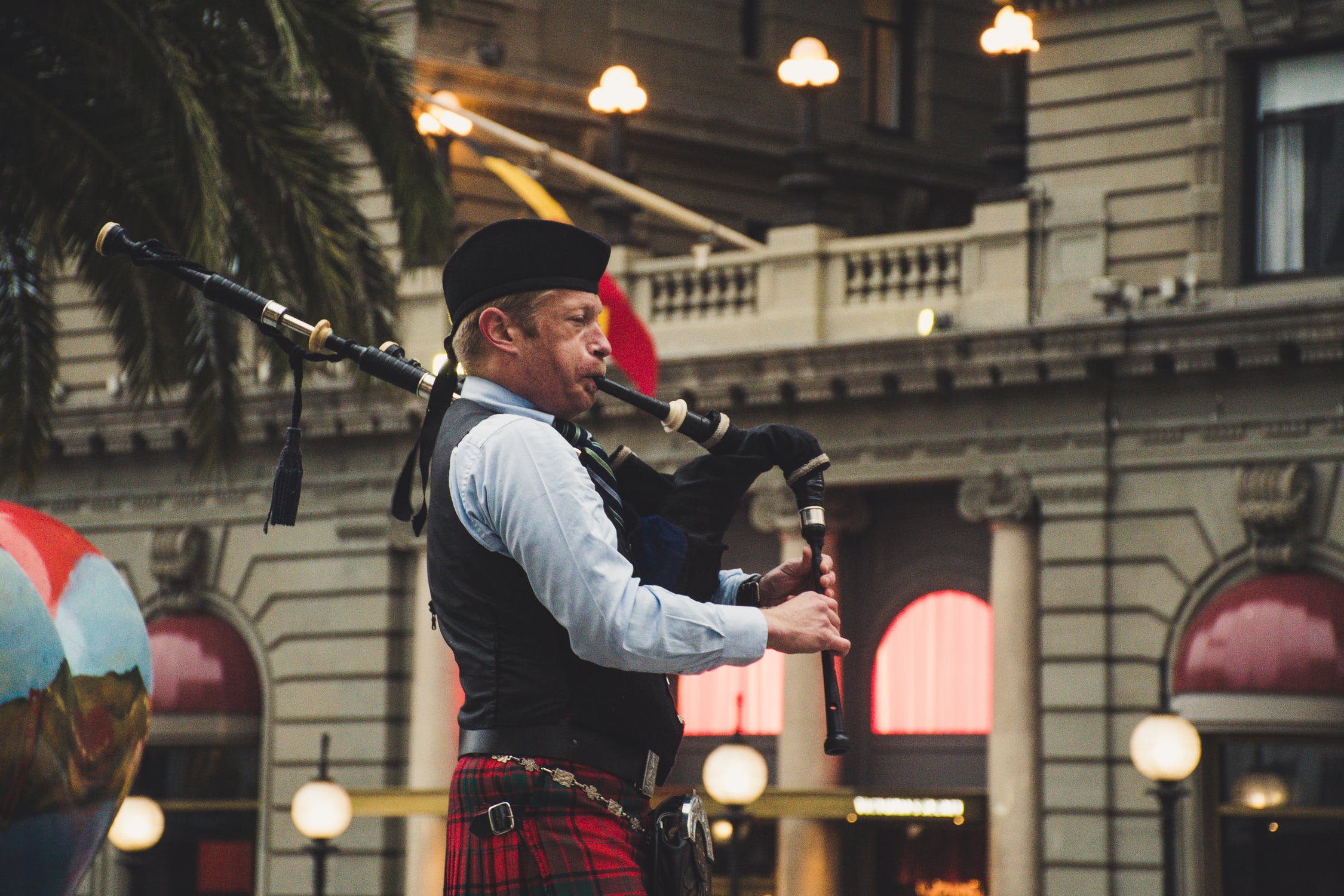 A Scottish bagpipe is an original instrument, and its Irish counterpart is its variant. Due to this reason, Scottish bagpipes come to mind when people think about these bagpipes in general.
A Scottish bagpipe is an original instrument, and its Irish counterpart is its variant. Due to this reason, Scottish bagpipes come to mind when people think about these bagpipes in general.
Scottish bagpipes are loud and big, but they have a limited scale to play with. As a piper, you will have to blow into the bagpipe to play it.
The traditional or standard Scottish bagpipe has a blowpipe, drones, a chanter, and a bag. This bag is filled with air that comes from the blowpipe. As a player, you will have to constantly refill them as you play while blowing into them from the blowpipe. This makes the bag a reservoir of air that the instrument uses to produce sound.
This bag is usually of animal skin, but you can find bagpipes with synthetic bags in modern times. It significantly reduces production costs, and the overall manufacturing process becomes simpler.
This bagpipe only has a single chanter, and there are three drones. This chanter has holes, and you can play it like a flute. The holes have to be constantly fingered for getting the right notes.
The drones here are different from Irish bagpipes, and they also have reeds but without any holes. So you cannot control them by any means. Therefore, they create that signature buzz present in the background. They also consist of a couple of tenor drones and a bass drone. It goes off as soon as you start playing the instrument.
Scottish Bagpipe Features
Blowpipe/blow stick
You have to blow air into these Scottish pipes with the help of their blowpipe or blow stick. Most of them come with an airlock system that can prevent air from escaping the bag and back into the blow stick. And you will need plenty of lung endurance to blow air into the bag constantly.
Bag
Of course, it is the most prominent section of the pipes and serves as an air reservoir for this instrument. It functions as the lung of the bagpipe and is mostly made of animal skins. The most common materials for these bags are goatskin, cowhide, or sheepskins. But the modern amateurs have developed synthetic materials to make these bags.
Gore-tex is the most common example of this scenario. But with synthetic fiber, there is an additional risk of any fungal spores. Therefore, some bags also come with zippers to make cleaning easier.
You have to compress air in the bag of a Scottish pipe with your arms. And you must maintain a consistent blowing as you control the pressure while compressing it.
You will need a lot of concentration, endurance, and control. As you compress the bag, the stored air inside goes through the chant along with the drones and creates a melody.
Chanter
Another part of the Scottish pipe is the chanter, and it’s the melodic pipe of this instrument connected with the reed. This pipe links with the bag as the blowpipe. It has a series of holes, and it looks like a flute.
This part not only looks like a flute but works like one too. Therefore, you have to use two fingers to block the holes and create a tune. It is of blackwood or any other similar material.
It can be conical or cylindrical in its inner bore shape. But for Scottish pipes, these chapters are mostly conical. This design significantly contributes to the pipes’ traditional percussive and loud noise. Whereas cylindrical chanters are quieter and sweeter.
Chanters have open ends, and as long as you put pressure on the bag, they will continue to pursue the melody. Therefore, most Scottish pipes have a legato sound characterized by no resting.
However, pipers have developed a technique to circumvent this matter. With technical movements, you can create an illusion of breaks and control the accents. But you will have to develop this technique with years and years of practice.
Scottish pipes have a flat 7th scale degree, while the range is one octave that starts from a single note lower than the tonic scale. Overall, the chanter has nine notes: low G, low A, B, C, D, E, F, high G, and high A. As there are limited chromatic notes, these bagpipes are in D Major, A Mixolydian, B Aeolian, and E Dorian (occasionally).
Drones
Just like the chanter, drones have reeds for producing sounds. But these drones don’t have holes, and you cannot control them. Therefore, they produce a consistent humming sound and harmonize the notes as you play. Most Scottish pipes have conical drones, which lie right over your shoulder as you play.
There are three drones in a Scottish pipe; a bass drone and 2 tenor drones. Tenor drones are about an octave lower than the low A or the chanter. Whereas the bass drone has 2 octaves lower.
How Are They Different?
We have talked about the overall difference in design and construction of these two bagpipes and how they are played, and the types of sounds they produce. But for a clearer understanding, let’s briefly discuss their differences further.
These bagpipes are suitable for parades as they produce a percussive sound. But in comparison to Irish bagpipes, the Scottish ones can produce limited music, so they are not very complex.
Meanwhile, Irish bagpipes are highly versatile musical instruments, especially the Uilleann pipes Trusted Source Uilleann pipes - Wikipedia The uilleann pipes (/ˈɪlən/ (audio speaker iconlisten) IL-ən or /ˈɪljən/ IL-yən, Irish: [ˈɪl̠ʲən̪ˠ]) are the characteristic national bagpipe of Ireland. Earlier known in English as “union pipes”, their current name is a partial translation of the Irish language terms píobaí uilleann (literally, “pipes of the elbow”), from their method of inflation. en.wikipedia.org . They can conveniently play a wider range of melodies and tunes with a wider scale and better octave range.
Irish bagpipes are suitable for people who prefer soft and sweet melodies. Moreover, these pipes also require less physical exertion than their Scottish cousins. But with that being said, Irish bagpipes are far more expensive, and they also need more maintenance
How Are They Similar?
They are played differently, and they have different constructions. So, even the sound they both products are not very similar. But you can say that some components exist in both of them.
For instance, they both have a bag along with chanters and drones, but they still have different numbers and construction. This gives an idea that both these instruments are similar, but they are not at all.










